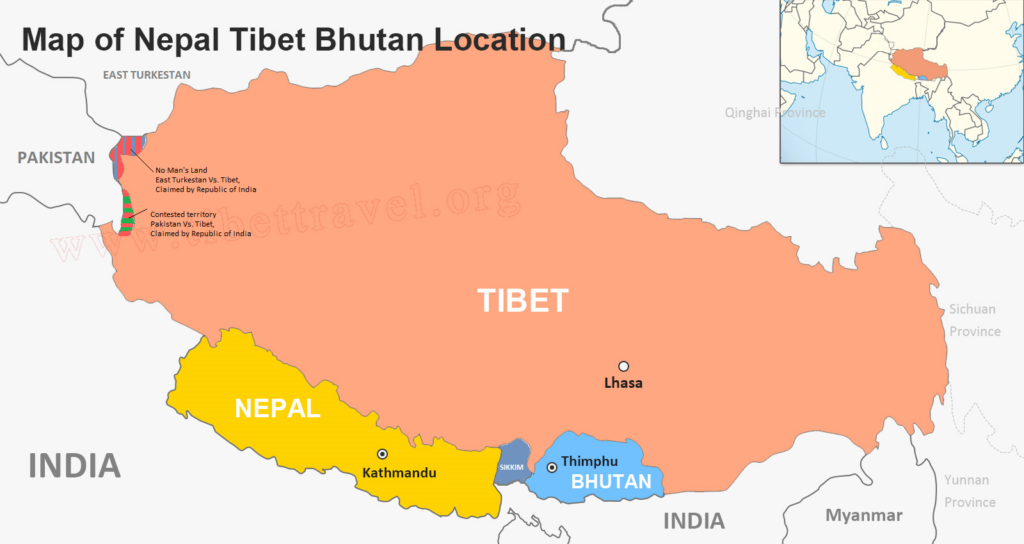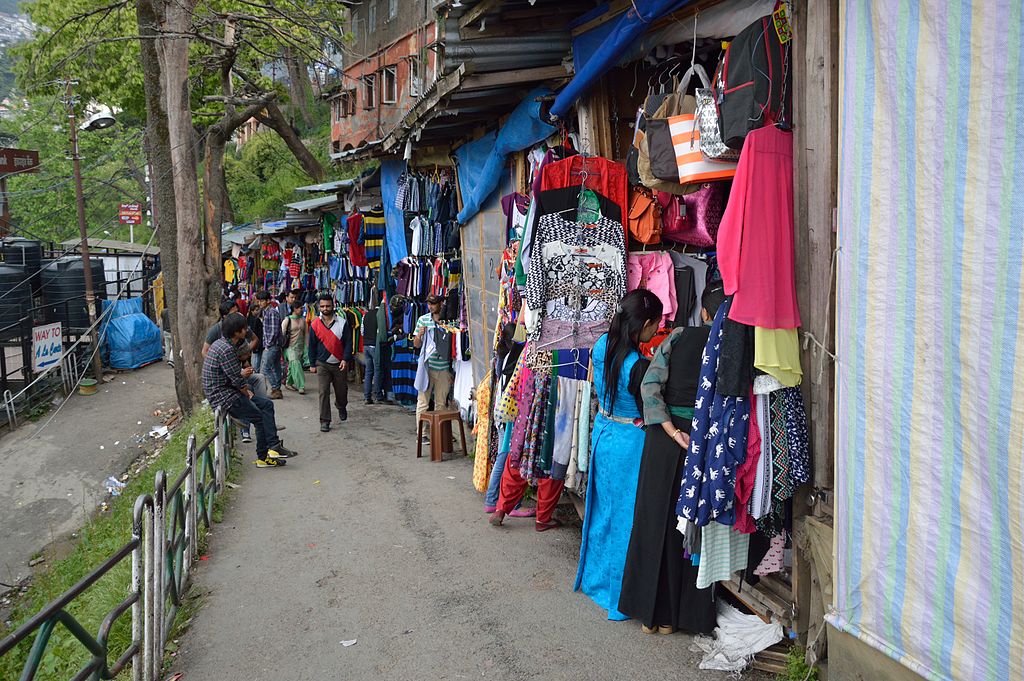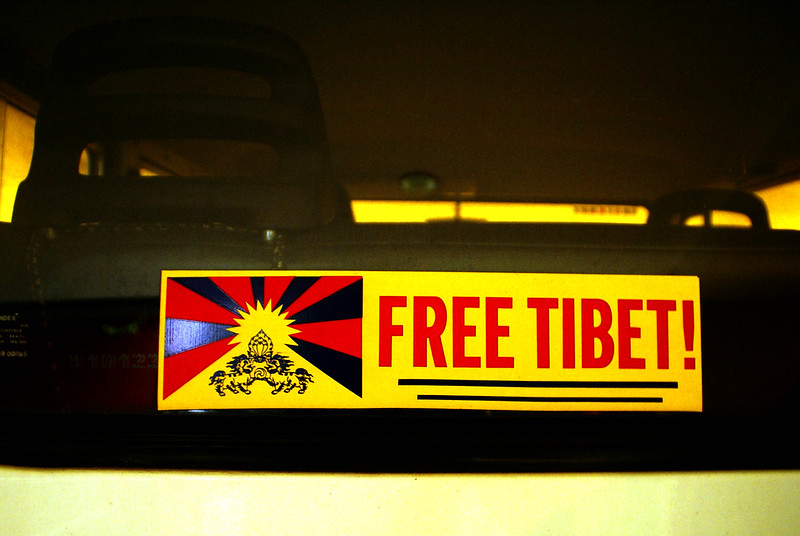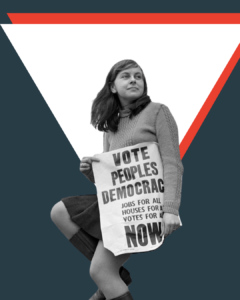
A ‘Save Tibet’ march through the streets of Los Angeles (10 Dec 2011). Photo by Gregg Lilly (via Flickr CC-BY-NC)
Navika Mehta presents a short guide to Tibet’s history of occupation and resistance movements on the anniversary of China’s annexation of Tibet in 1951.
Tibet is a country in the Himalayas. Measured by land-size of 2.5 million square kilometers, it is the world’s 10th largest nation. This area includes U-Tsang, Kham and Amdo provinces. His Holiness the 14th Dalai Lama, Tenzin Gyatso, is the spiritual leader of Tibet.
For centuries, Tibet existed as an independent nation until 1950 when the Chinese Communist regime invaded. Tibet’s occupation gave China access to rich natural resources and a strategic border to India.
Following the invasion, years of struggle ended in the self-imposed exile of the Dalai Lama and 100,000 Tibetans in 1959. On 10th March 1959, Tibetan resistance led to the Tibetan National Uprising against the Chinese rule in Lhasa.
The occupation has contributed to the deaths of over a million Tibetans due to torture, direct conflict, starvation, suicide and resistance (“struggled”). After more than 70 years of occupation, Tibetans still resist China’s rule.
In exile, the Central Tibetan Administration (CTA) along with the people of Tibet, under the leadership of His Holiness the Dalai Lama have led a struggle based on non-violence, truth and justice to reclaim their freedom and dignity. According to the CTA, the population of Tibetans is approximately 6 million people.
The largest group are in exile in India with 94,203 Tibetans. Other countries with a large population of Tibetan refugees include Nepal and Bhutan. The Tibetan government in exile is Democratic and popularly elected with a Parliament in Exile of 45 members.
Human rights violations in Tibet
Since the invasion, Tibetans have been subjected to human-rights abuses at the hands of the Chinese government. Regular human rights observer NGO Human Rights Watch, found that China’s Public Security Bureau in the Tibetan Autonomous Region declared traditional and social activities among Tibetans as illegal, in a 2018 report. Other organised environmental and cultural initiatives along with traditional practices and informal welfare associations, known as kyidu, are considered a threat and have been declared as illegal.
According to the latest World Report 2022 by HRW, freedoms of religion, expression movement and assembly are severely restricted:
- Tibetans are detained for alleged online offences, particularly those who contacted people outside China.
- The government has imposed coercive assimilationist policies such as the imposition of Chinese language classes.
- High levels of surveillance, online and offline have made protests impossible in Tibetan areas.
- Statistics on the number of prisoners are unclear because of information control but at least 8 Tibetan prisoners were released due to ill health or torture, four died soon after.
Tibet in India
The movement of thousands of Tibetan refugees to India was followed by the Dalai Lama’s exile in India.
While they are now scattered across India, a large population resides in the north. Dharamsala, a city in Himachal Pradesh is the residence of the Dalai Lama and the Tibetan Government in Exile. Missouri and Dehradun in Uttarakhand also have large settlements of Tibetan refugees.
In these cities there are “Tibetan Markets” that are Tibetan Welfare Markets protected under the Societies Registration Act 1860, and are run mostly by Tibetan women.
While visiting Dehradun’s Tibetan Market in January 2022, I interacted with a woman called Dolma, who has been living in India since 1962, having fled Tibet as a 10-year-old.
Dolma explained that she had lived in the north across several cities before settling in the Gapheling Tibetan colony in Dehradun. She has worked at the Tibetan market for the last 40 years.
During the pandemic, this “physical” market suffered immensely, with people choosing to shop online and closures of the markets along with fear of the pandemic, the footfalls and sales dropped drastically. This was a difficult time for the women who run these markets. Dolma also told me about the Tibetan Women’s Association (TWA).
Tibetan women and the TWA
The Tibetan Women’s Association was founded on the 12th of March in 1959. This day came to be known as the Women’s Uprising Day as thousands of Tibetan women in Lhasa protested by gathering on the ground called Dri-bu-Yul-Khai in front of Potala Palace in Lhasa and organizing enormous processions on the streets, against the illegal Chinese Occupation.
They faced brutal force and arrests with indefinite prison terms with many women being beaten to death.
Today the TWA, which was reinstated in 1984, has 12 branches across India with over 16,000 members. Members:
- raise awareness about the human rights abuses that Tibetan women faced in the Chinese-occupied Tibet.
- highlight gender-specific torture and forced sterilization and abortions.
- organise activities to promote Tibetan culture and religion to preserve Tibetan traditions in exile. These projects address social welfare, educational and environmental needs of the community in exile.
The Free Tibet movement
Free Tibet (FT) is campaigning and education non-profit, non-governmental organisation founded in 1987 based in London. Free Tibet advocates for:
“a free Tibet in which Tibetans are able to determine their own future and the human rights of all are respected.”
An example of Free Tibet’s actions to spotlight abuses and denials of human rights was visible during the 2022 Beijing Winter Olympics. The group were vocal on drawing attention to the host country, China, where the winter games went against the spirit of Olympics (“No rights, no games!”) as many participating countries ignored the scale of human rights abuses suffered by Tibetans, Uyghurs, Hongkongers, Southern Mongolians and Chinese citizens.
A statement by a coalition of campaign groups in June 2021 in advance of the games was direct and unequivocal:
“The Chinese government uses human rights abuses to get its way and to suppress protest. When Tibetans protested during the 2008 Beijing Summer Olympics they were brutally put down. Since then more than 1 million Tibetans have been entered into coercive labour and relocation programmes designed to disrupt traditional ways of life. Over a million Uyghur people have been detained in concentration camps and up to 500,000 are being forced to pick cotton.”
In terms of surveillance and technology, Chinese authorities control one of the biggest manufacturers of CCTV cameras in the world, Hikvision. Free Tibet campaigns on this issue regularly. Nearly two-thirds of UK councils use CCTV Hikvision cameras; the same ones used for surveillance of Tibetan and Uyghur people.
Supporting Tibetan Refugees
Tibetans in exile face many issues from unemployment to difficulty in accessing education and state services as asylum seekers. We can support them by joining campaign groups that lobby governments to provide better supports and learning more about the issues.
On this Tibetan Uprising Day, remember the struggle of Tibetans across the world, those still in Tibet and raise awareness about the inhumane treatment and human rights abuses they have suffered and are still facing.
Free Tibet mobilize active support for the Tibetan cause, human rights and challenge the actions of the occupation forces. Their campaigns are funded by supporters across the world, such as No Beijing 2022 and Hikvision in the UK.
Find out more about Free Tibet support groups across the world and think about how you or your groups can link in
- Navika Mehta is a Teaching Fellow in Economics at Trinity College Dublin. She is an activist who campaigns to end racism and Direct Provision.







